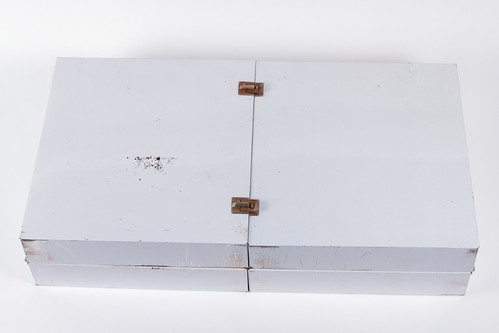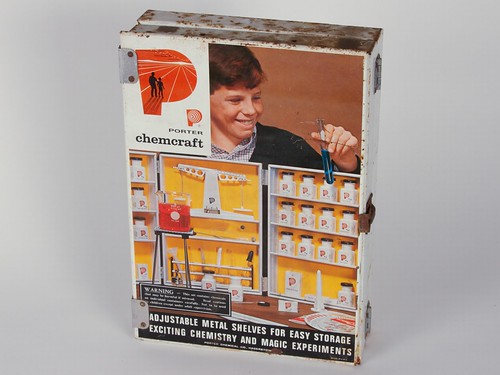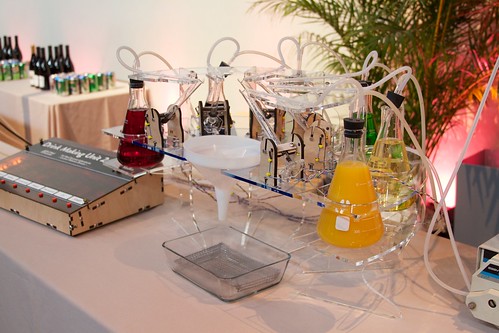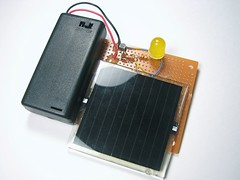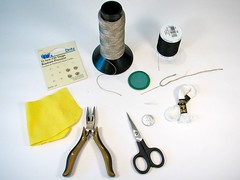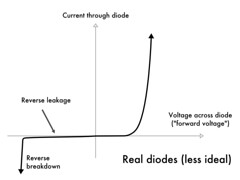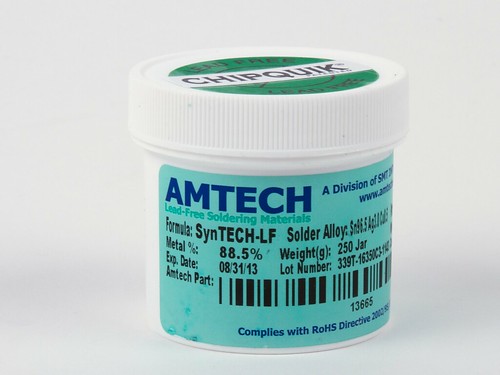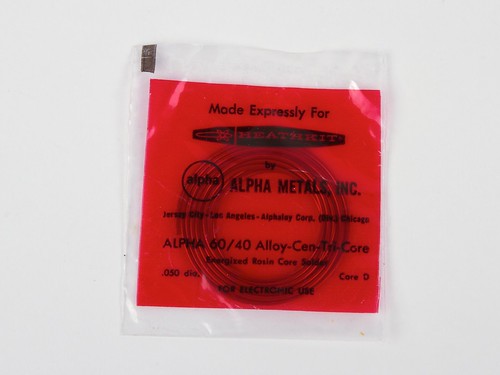A good friend recently presented us with his estate sale find: two 1960’s era vintage chemistry sets. One set is big, white, and mysterious, the other is smaller but showier. Let’s take a look at what’s inside!
All posts by Windell Oskay
Drink Making Unit 2.1
While we are better known for other types of art robots (like the Eggbot and now the WaterColorBot), we have also been involved with cocktail robotics for the past few years.
After a half-dozen cocktail robotics event over the past couple of years, we’ve had a chance to refit our famous bar-bot, Drink Making Unit 2.0, with a few well-earned upgrades. Read on for the gory details!
Introducing The WaterColorBot
Today we’re thrilled to be launching our newest kit: the WaterColorBot.
The WaterColorBot is a brand-new project from Evil Mad Scientist Laboratories and Super Awesome Sylvia — a friendly art robot that moves a paint brush to paint your digital artwork onto paper, using a set of watercolor paints.
We’ve previously written about how we got started on this project (in a guest post by Sylvia), and about Sylvia’s visit to the White House Science Fair, where she was able to give President Obama a personal demonstration of the WaterColorBot.
And now, you can get one too! We’re launching the WaterColorBot today on Kickstarter, and we’d like to ask for your support in getting it out there. The WaterColorBot is an enormously powerful tool for helping to get young people interested in technology:
Beyond simple fun, we think that the WaterColorBot has enormous potential for STEM and STEAM education, especially as a way to get young people engaged with hands-on technology and robotics. We are particularly interested finding ways to inspire young women to pursue careers in science and technology. We cannot imagine any better way to do so, than starting with a robot co-designed by a 12 year old girl.
Perhaps more than anything else that we’ve done, we think that the WaterColorBot really can make the world a better place, one (young) Evil Mad Scientist at a time.
Field Trips: Tesla Motors, Palo Alto
Recently, we were invited along for a short tour at the corporate headquarters of Tesla Motors in Palo Alto. And, we brought our camera.
A round up of our “Basics” articles
Over the course of the past few years, we’ve been writing occasional “Basics” articles, about introductory topics in electronics and microcontrollers. In the spirit of making things easy to find, we’ve now tagged them so that you can find them with this link, and we’re collecting them together in this index that will be updated from time to time.
Our “Basics” articles about electronics in general:
- Basics: Picking Resistors for LEDs
- Basics: Finding Pin 1
- Basics: Open Collector Outputs
- Basics: Simple LED Pumpkins
- Simple Solar Circuits
- Basics: Introduction to Zener Diodes
- Basics: Power Dissipation and Electronic Components
- Soft Circuit Merit Badge
- Basics: Up Close and Personal with Solder Paste
- Five Electronics Tools You Might Not Know About and More Cool Electronics Tools
- Tricks of the trade: Twisting wire bundles
Additional “Basics” articles about working with AVR microcontrollers:
- Basics: Blink an LED with an AVR microcontroller
- Using AVR microcontrollers: Minimalist target boards
- Basics: Serial Communication with AVR Microcontrollers
- Basics: Using an Accelerometer with an AVR Microcontroller
- AVR Basics: Reading (and writing) flash contents
- Quick and Dirty D to A on the AVR: A timer tutorial
- Resources for getting started with AVRs
Bullet Time Fireworks with a GoPro and a Ceiling Fan
Just in time for the Fourth of July, Jeremiah Warren created an incredible relatively low-budget “bullet time” rig— with a 240 fps GoPro camera mounted to a ceiling fan —to photograph fireworks. He posted a full writeup showing how to build it on his web site.
The clever hack about using the GoPro on the ceiling fan is thanks to Mark Rober, who showed how to do it back in May, mostly with smaller-scale subjects. But Jeremiah has taken the idea and run with it, adapting it for larger-scale photography.
And as you can see, the results are simply fantastic.You can find more videos and the full how-to on Jeremiah’s site.
Open Discussion: Does Solder Expire?
When we recently wrote about looking at solder paste up close, we happened to mention that it has a shelf life— something that you might expect to be uncontroversial considering that there is an expiration date, printed right there on the jar.
But, our reader Trav commented
Very nice pics. What happens to solder paste when it expires? does it taste funny? Do the balls go flat?
I assume the paste rather gets runny and doesn’t hold the solder in place or it gets thick and won’t spread evenly.
I’ve heard of it expiring, but never knew how. I’ve had a tube of flux for 20 years now. When it gets too thick, I put in a couple drops of alcohol and it seems to work good as new.
We like the “balls go flat” theory! But seriously, we presume that they wouldn’t label paste with a short shelf life— typically 4-12 months, when kept refrigerated, depending on the type of paste —unless there were a reason (and hopefully, a good reason) to do so.
A blog post on the Indium Corporation web site offers a little insight. It turns out that the “activator” chemicals within the flux, which serve to clean oxides off of the surfaces that will be soldered, also interact with the microscopic solder balls, gradually scouring off their surface oxides. When the solder particles are clean enough, they can actually cold-weld together, resulting in increased effective grain size and viscosity. As Trav notes, adding a little alcohol can reduce the viscosity of flux, but we can see how increased grain size and other factors (such as having used up some of the activators) could affect performance in other ways.
But in any case, it sounds like there are a range of experiences out there, and we would like to open the question for discussion: What has your experience been with out-of-date solder paste? Has it worked just fine? And if not, what was the failure mode?
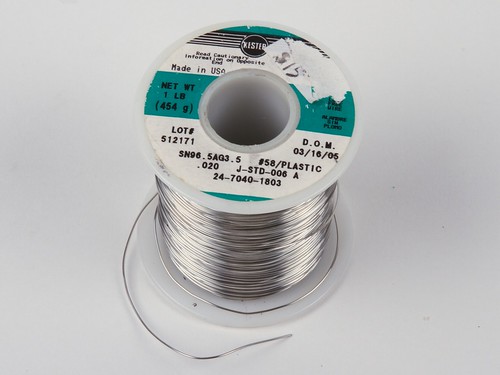
Separately, what about (flux-cored) solder wire?
Kester has this to say, in their policy about shelf life:
Flux cored solder wire has a limited shelf life determined by the alloy used in the wire. For alloys containing more than 70% lead, the shelf life is two years from date of manufacture. Other alloys have a shelf life of three years from date of manufacture.
So, our spool of lead-free solder pictured above, with date of manufacture 3/16/05 expired five years ago in 2008. Presumably one reason for a stated expiration date is that the flux becomes less active over time as it interacts with the solder metal.
But in our personal experience, this kind of solder seems to generally work just fine, even many years past its nominal shelf life.
Many others seem to have had a similar experience with solder wire.
When we wrote about assembling a vintage Heathkit, we mentioned that it came with solder. It actually came with two little packets of solder, specifically 60/40 rosin-core, cheerfully labeled “Made Expressly For Heathkit by Alpha Metals, Inc.”
Seeing as (1) the kit and solder date back nearly 40 years, (2) Alpha Metals also uses the three-year figure for shelf life, and (3) we already had a fresh, open spool of Alpha Metals 60/40 rosin-core solder in the lab, we opted to use the fresh spool and save the vintage solder packets for a rainy day. Were we wrong to do so? Certainly, some of our readers thought so:
Solder shelf life? Are you sure about that? Solder paste has a shelf life but I’ve never heard of a shelf life for a real coil of 60/40 rosin core solder. I’ve used some pretty old stuff myself, a quick Google search for solder shelf life found me a discussion where a guy is talking about using solder from the 60s with no problem on the first click!
So what has your experience been? Have you used “old” solder, and if so, how well did it work?
The 2013 Open Hardware Summit: Call for Papers Extended
Good news if you’re still working on— or haven’t yet started —your proposal for this year’s Open Hardware Summit: The call for papers has been extended, so you’ve got another week to fine tune your talk, poster, or demo proposal.
Submissions are now due by JUNE 28, 2013.
The Open Hardware Summit is the world’s first comprehensive conference on open hardware; a venue to discuss and draw attention to the rapidly growing Open Source Hardware movement. This year’s summit takes place on September 6 at MIT.
Previously: The 2013 Open Hardware Summit: Call for Papers,
The 2013 Open Hardware Summit: Tickets Now Available
Photo credit: Open Hardware Summit on Flickr.
Introduction to Analog Mechanical Computers
Courtesy of the United States Navy comes this incredible introduction to analog mechanical computers.
The context for this is that massive, mechanical computers were used aboard US Navy ships ranging from destroyers to battleships, from about 1944-1969, as part of the “Fire Control” system. This type of computer would take up to 25 continuously changing input variables in order to calculate the proper bearing and elevation for heavy caliber guns aboard the ship. This calculation— to ensure that a projectile will land at the place where the target is going to be —is marvelously complex, taking into account variables such as wind speed and direction, relative velocity of the ship and target, and parallax between the different guns on the ship. What’s truly remarkable is that it was all done with mechanical mechanisms such as gear differentials, cams, and mechanical integrators.
This two-part training film, from 1953, introduces the basic mechanisms that made these computers work:
The video embedded above (41:53 total length) contains both films, one after the other. (And, the YouTube link is here.)
Basic Mechanisms in Fire Control Computers, Part 1 discusses shafts, gears, cams, and differentials. Note that the first couple of minutes are not so much about the mechanisms, but more of an explanation— to the servicemen —of why they needed to learn about them.
Basic Mechanisms in Fire Control Computers, Part 2 discusses component solvers, integrators, and multipliers
If you enjoy these training films, you may also want to read through the little book entitled Ordnance Pamphlet 1140: Basic Fire Control Mechanisms, available here in PDF format, which covers much of the same ground.
The Evil Mad Scientist STEAM T-shirt
Introducing the Evil Mad Scientist Laboratories STEAM T-shirt. Featuring high quality screen printing on 100% cotton tees from American Apparel.
Front side: Science & Technology & Engineering & Art & Mathematics. (Black ink)
Back side: The Evil Mad Scientist logo. (Red, brown, and black inks)
Shirt color: “New Silver,” a uniform light gray.
These are Great Shirts
Beautiful quality screen printing by Social Imprints of San Francisco (“Printing with Purpose”).
The shirts themselves are comfortable 100% cotton tees, made in the USA by American Apparel. (Mens Fine Jersey Short Sleeve T-Shirt and Womens Fine Jersey Short Sleeve Women’s T.)
Inspiration
The design of the front is an homage (like so many others) to the John Paul Ringo George shirt by Experimental Jetset.
Why Science & Technology & Engineering & Art & Mathematics?
It’s who we are, and it’s what we stand for.
Why not just STEM?
We, like many, many others believe that art is a critical component of good design, of good engineering, and of beneficial technology.
Get yours
The Evil Mad Scientist STEAM T-shirt is in stock and shipping now!




